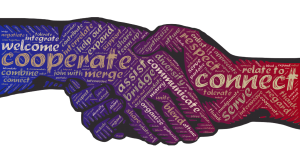Or are we more than that? The Learning Technologist – Faculty Liaison (FL) role was introduced by CTEL (Centre for Technology Enhanced Learning) in August 2017 to act as a direct liaison with academic faculties and departments. The main aim of the role is to support the management and delivery of multiple projects aimed at both the development of academics’ pedagogic understanding and the practice of technology-enhanced learning. In short, acting as the conduit (inbetweeners) between faculties/departments and CTEL whilst also improving engagement with key staff members on new initiatives from initiation right through to completion.
 A key part of our role is making sure the faculty voice is heard at all levels within CTEL and IT, ensuring that staff support and student experience is core to all we do. However, one of the main challenges that we have faced is that we have multiple TEL ( Technology Enhanced Learning) staff based within each faculty through several campus locations.
A key part of our role is making sure the faculty voice is heard at all levels within CTEL and IT, ensuring that staff support and student experience is core to all we do. However, one of the main challenges that we have faced is that we have multiple TEL ( Technology Enhanced Learning) staff based within each faculty through several campus locations.
So, who do we liaise with we hear you ask? Well, our faculty contacts are mainly TEL focused staff e.g. Learning Technologists, TEL Academic Leads and Instructional Technology Managers; however, we also provide bespoke guidance/training for academics when the faculty hasn’t got the capacity, expertise or experience to provide this themselves.
The FL Team is made up of four Faculty Liaisons managed by Sue Harrison, Senior Learning Technologist:
 Catherine Bone & Sultan Wadud
Catherine Bone & Sultan Wadud 
Kim Rowland & Riaz Toorabally
Catherine was the first Faculty Liaison and started in the role in August 2017, with Riaz joining in October 2017 and then both Kim and Wadud completing the team in March 2018.
The team brings a mix of skills and a diverse range of expertise. It was therefore decided that we be paired up together and faculties are split between the two FL sub-teams. This pairing has thus worked effectively as we have been able to complement each other by drawing upon our academic and technical experience when contacting our allocated faculties and departments. For example, when recommending the use of a new video hosting service Kaltura we have been able to provide guidance and support both from a pedagogical and technical point of view.
Working as a FL it has become apparent that there is a cross over with a business analyst role which includes tasks such as data gathering, needs analysis and reviewing processes to name a few. However, where the FL role differs is that we have the specialism to focus specifically with TEL and working in collaboration.

This is the first time that CTEL has people on the ‘ground’. This has allowed us to act as a single point of contact between the faculties and IT services ensuring any concerns or needs are relayed back to the appropriate stakeholders whilst capturing valuable insights to the varying workings within each faulty.
All in all the role itself has been active for just over year, yet we have already established good links with key TEL contacts within each faculty. Looking towards the future we intend to continue expanding our contacts in particular with academic and professional staff to enable us to have a more holistic understanding of each faculty.